Eating Tuscan Dust
This article originally appeared on Peloton Mag
The gravel renaissance is in full throttle, but gravel roads are certainly not an embrace of a trend in the Renaissance heartland of Tuscany. While we use the term gravel, the Italian term sterrato (which translates as “unpaved”) is really most appropriate here. When dry, the strade bianche are hardpacked earth roads. The Italian history of road construction dates to the Etruscans and pre-Roman times when roads were mostly beaten tracks of earth. These now celebrated white roads of Tuscany are very practical byways, whether for moving farm equipment from field to field or taking children to a village school.
While the rest of the world seems in a rush to pave paradise--as Joni Mitchell sang in “Big Yellow Taxi”--the Italians have opted to keep this part of their past intact. In creating L'Eroica (and later the Strade Bianche classic), Giancarlo Brocci aimed to take us all back to a time when Italian legends Fausto Coppi and Gino Bartali rode and raced Italy's dusty tracks. The title of the original mass ride--”The Heroic”--feels immediately appropriate within a few pedal strokes when contrasted with the relative ease with which modern paved roads are to navigate by bicycle.
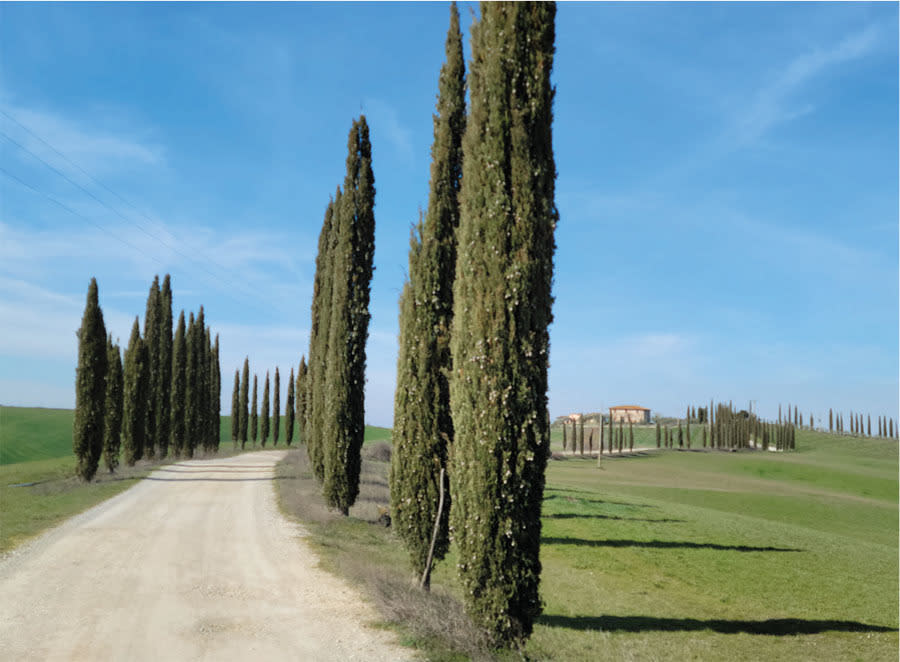
I spent nearly a week at the Podere Ferranesi hotel, 30 kilometers southeast of the classic Italian hill town of Siena, exploring both the paved and the sterrato roads. The USA Cycling Foundation with cycling and adventure company DuVine have put together a Strade Bianche outing as part of their “challenge series.” That means (unlike most bike tours) the rides are not leisurely in length or terrain; and on this trip were some accomplished riders, including serious masters racers, a couple of youngsters who descended like their hair was on fire and former pro racer Lauren Hall. We received our share of the Tuscan white roads culminating in a two-day Strade Bianche race experience: one as spectators and the other as gran fondo riders.
Equally important were the espresso stops and an in-depth exploration of the local wine and food scene--culture, after all, is my particular beat.
Our guides Marco and Valentino, both Tuscan born and raised, piloted us among the sharp climbs and equally challenging descents found in the Val d'Orcia and Val d'Asso. This is prime white road territory with intersections often marked by “L'Eroica” signs. Our guides' local insight, along with their flourishes of what feels like Italian poetry, made the conversation and the miles pass with a little less pain in the legs. And they helped us navigate the menu in the evening. While we love to romanticize Tuscany, it puts a serious hurt on you if you show up a little under-prepared; and I did just that. The climbs here are constant, and 100 feet per mile ridden seems to be a law of the land, no matter the route or the distance you choose.
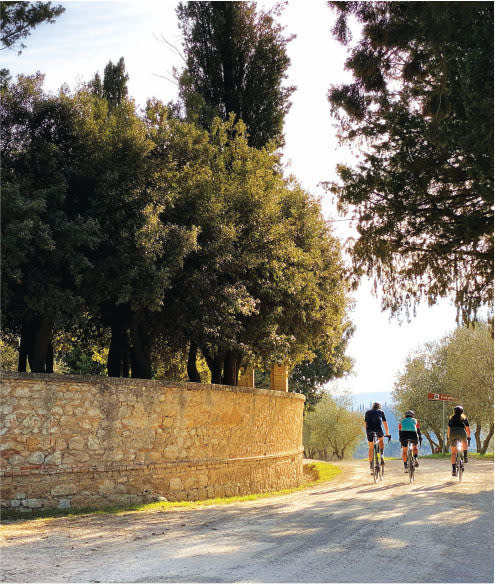
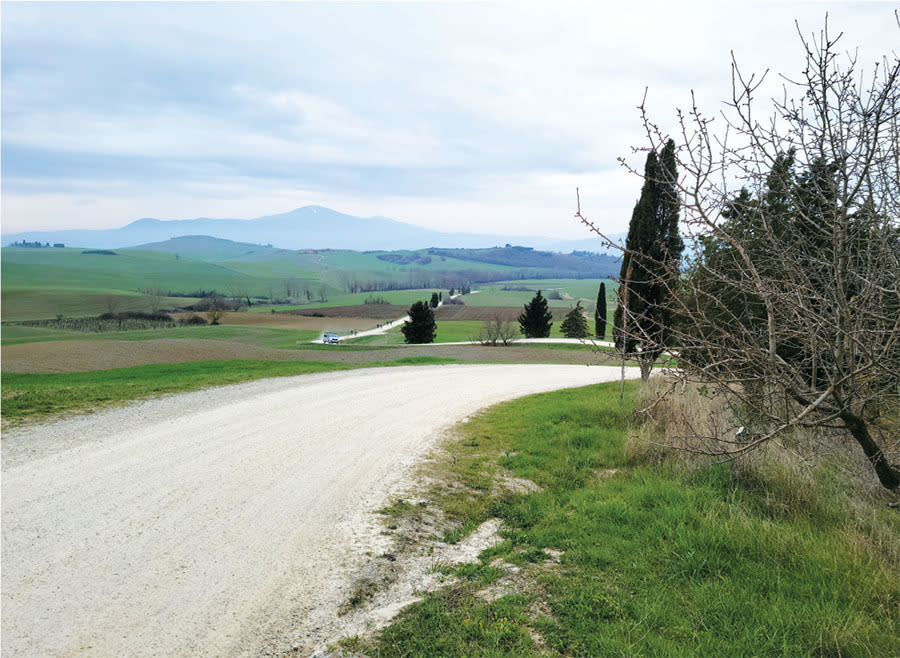
After a fairly warm winter, a cold snap gripped Italy in the early days of March. The sunshine was appreciated, but when grinding up some of the signature Tuscan climbs it dawned on us how difficult this would be under the duress of higher temperatures.
The early-spring grass made the signature Tuscan views feel like everywhere was particularly beautiful. Perhaps the steep, endless climb to Castiglione del Bosco and its jaw-dropping surroundings embodied Tuscany most of all. After descending onto an unpaved sector from one of the local strada provinciale, a long flat white road began slowly rising flanked by the region's iconic cypress trees. This is story book stuff.
The road rose sharply, with long segments of the forested hill in excess of 15 percent. This is where Egan Bernal last year buried Remco Evenepoel's maglia rosa dreams in stage 11 of the Giro.
These roads are lined with vineyards that produce the grapes for Tuscany's most famous wine, Brunello di Montalcino. From the top of the Castiglione del Bosco climb we descended a long, black tarmac strip, passing some of the region's most wellknown wine producers, to Sant' Angelo in Colle (population 204), where an espresso awaited at the coffee bar.
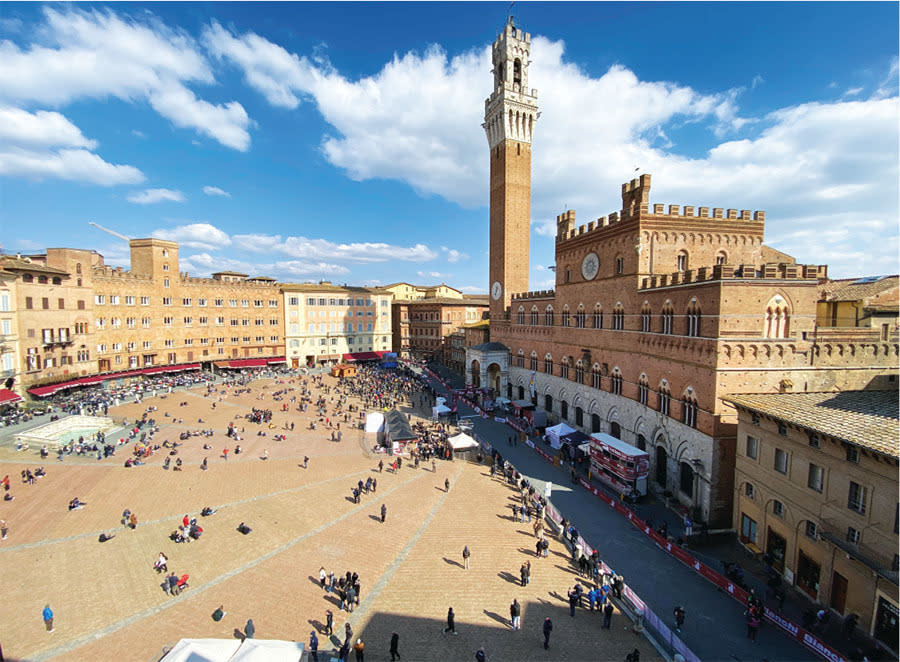
The long dusty white road from town led us to the slightly larger village of Castelnuovo dell'Abate (home to 233 folks); but on the way we stopped at Ciacci Piccolomini d'Aragona, an upstart Brunello producer. The 17th century estate, built by the Bishop of Montalcino and the Abbot of Sant'Antimo Abbey--which was a bit farther along the road. The estate was eventually purchased by a countess in the latter part of the 19th century. These days it's owned by the Bianchini family, which used to farm the estate for the countess before she bequeathed it to them in 1985. The owner and winemaker is Paolo Bianchini, who left working the estate for a spell in the 1990s to race professionally for the Colnago team.
We settled in for lunch in the winery's dining room, which Paolo has turned into a cycling museum. Salami with truffle, deep green olio nuovo and loads of pecorino cheese were consumed by a group of hungry riders, surrounded by signed jerseys. Names like Sagan, Moser, Bettini, Nibali and Hampsten decorated the walls while a dozen or so classic racing frames, including a cherry-red Colnago, hung from the rafters above our heads. We sampled some of Paolo's brilliant Brunello and then we were back on the road.
TO SIENA
Compared to our sleepy lodgings in a villa outside the village of San Giovani d'Asso, the city of Siena was electric on race day, as buses for the men's and women's WorldTour teams clogged the streets around the walls of the 16th century Medici Fortress, and fans jostled one another for a chance to glimpse the likes of Julian Alaphilippe and Tadej Pogacar.
We picked our way out of town by bike to preview some of the race's sectors in preparation for the following day's gran fondo, as well as to measure ourselves against the pros on the climbs. The race's final climbs--sector 10, Colle Pinzuto, and sector 11, Le Tolfe--are usually the difference makers. Both sectors welcome you in deceptively. On the first, you navigate around a small stand of trees on the way to the really steep left turn at Colle Pinzuto, and then you're into 15-percent territory for quite a while. Le Tolfe has a steep descent right into a wildly steep climb--and even some strong riders find themselves walking it.
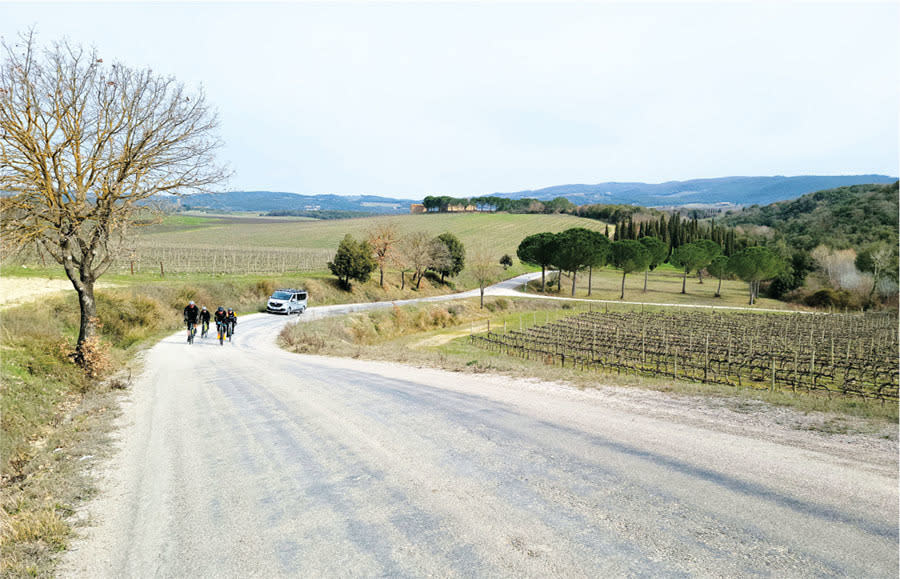
After scouting the course, we hit the greatest stretch of sterrato in all of Tuscany. Tucked in between Colle Pinzuto and Le Tolfe there's a long stretch of flat white road that you can take at any pace you'd like. It's not a named sector, but it has a better ending than all the others. At the end of the road, you find yourself at Serena's house. Our guide Valentino grew up here, and his mother Serena had spent all morning preparing to welcome us to a riposo that happened to coincide with Valentino's birthday.
We were welcomed into the yard by a skittish dog and Marco, who grew up with Valentino. Valentino's mom welcomed us into her home with a glass of Prosecco and a zuppa made from chickpeas grown in the family garden. Serena pulled off a number of delicious courses including a stewed beef in tomato sauce that just melted in your mouth. We washed it all down with an ultra-local, rustic Sangiovese wine. Valentino's beautiful young daughter clung to him while all these strange people speaking a different language filled her grandmother's living room. Watching Strade Bianche on the television and basking in the warmth of home-cooked Tuscan hospitality, this was heaven on earth.
With our bellies full, and about 40 kilometers of the race remaining, Serena directed us out the door and a few hundred yards away to the hairpin bend on the climb to Colle Pinzuto. The approaching helicopter signaled that Pogacar was nearly upon us. Fans packed both sides of the road--and some of them had definitely knocked back a few Peronis. The energy was intense for the race leader and pursuing Kasper Asgreen, as well as for the Alejandro Valverde group. The groups farther back were given the Italian equivalent of “attaboy” in between conversations and the collective enjoyment of a return to normalcy for a country once so devastated by the coronavirus pandemic.
The next morning, we chased the gran fondo crowd along the dusty, four-star Bagnaia sector, and enjoyed the sections of perfect tarmac that led us into the sectors of Monteaperti and our old friends from yesterday, Colle Pinzuto and Le Tolfe. Our knee warmers were covered in dust as we reach the final paved climb into Siena, the Via Santa Caterina. We celebrated new friendships and washed the dust from our throats with glasses of Tuscan wine and hearty bowls of pici, the local handmade pasta specialty. Tuscany had worn us out in the best way possible.
While it's certainly possible for anyone to go over and check out the Strade Bianche race or register for the gran fondo, the DuVine Strade Bianche tour offered a Tuscan insight that you just can't replicate. While decidedly a luxury tour, it was certainly not leisurely. And each subsequent morning was made a bit easier thanks to Margarita, the trip's soigneur. There were homecooked meals and exclusive-restaurant experiences. The lunch I had at Valentino's family home will be a memory I'll carry for the rest of my life. Tuscany is one of the most wonderful places in Italy and all the world, and for us to experience it so authentically was an unrepeatable experience.
For exclusive access to all of our fitness, gear, adventure, and travel stories, plus discounts on trips, events, and gear, sign up for Outside+ today.

